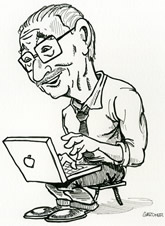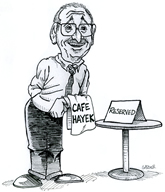China was just emerging as a major trading partner in the global economy 30 years ago. The United States imported only $48.5 billion in Chinese goods in 1995. Today we import $439 billion from China. This growth has enriched both countries.
Economists have understood for more than 200 years that trade flows between nations according to “comparative advantage”: each country produces what it can make relatively more efficiently. This results in a larger economic pie for both countries, which translates into better living standards for ordinary people.
Toys and furniture are two of the largest categories of consumer imports from China. Toy prices are down 87.5 percent since 1995, and furniture prices are essentially unchanged. Televisions and apparel are two other popular categories of imports. Since 1995, television prices are down 98.5 percent and apparel prices are unchanged. Meanwhile, the overall consumer price index has increased by 111 percent.
The lowered cost of production associated with Chinese trade is a major reason these prices have decreased relative to inflation. That translates into a real wage increase since ordinary Americans can afford to buy more. Meanwhile, increased imports haven’t shrunk the number of jobs for Americans. Total civilian employment has grown from 132 million in 1995 to 170 million today.
International trade doesn’t change the number of jobs in the U.S. economy. It changes the mix of jobs. We tend to lose low-wage, low-productivity jobs and gain high-wage, high-productivity jobs. Trade restrictions might shift some low-wage jobs back to the United States, but does anyone really think America becomes better off by bringing back Chinese sweatshop jobs?
While we would become poorer if we brought back sweatshop jobs, these same jobs are a step up for Chinese citizens. In my recent book, Out of Poverty: Sweatshops in the Global Economy, I investigated the wages of workers in factories deemed Chinese sweatshops. The average sweatshop worker earned nearly $14 a day between 2010 and 2019. During this time, roughly 20 percent of China’s population lived on less than $6.85 per day.
At the height of a brief trade war with Europe in the 1960s, President Lyndon B. Johnson imposed a 25 percent tariff on imported passenger trucks and vans. It was a retaliatory measure aimed at punishing European countries — France and West Germany, mostly — for tariffs they had slapped on American chicken.
That trade war ended long ago, but that 25 percent tariff on pickup trucks and cargo vans remains to this day. In practice, the “chicken tax” makes imported vehicles more expensive. But that’s not all. It also limits American consumers’ choices. The Toyota Hilux, for example, is one of the most popular pickup trucks in the world but is not sold in the United States. The tariff is also part of the reason American-made pickup trucks are so pricey: U.S. car companies can charge more because they face less competition.
…..
In theory, the sweeping tariffs Trump has imposed this year should be easier to dislodge. They’re so broad that they create fewer industry-specific beneficiaries to lobby for their continuation, and they could be canceled with an executive order rather than requiring an act of Congress. The fact that the public “is very aware of the new tariffs and so far has taken a pretty strong negative view of them” could give a future Democratic president or congressional majority the necessary push to scrap them, [Ed] Gresser added.
But the very nature of the political system could help them hang around — if the courts don’t strike them down, that is. Expansions of presidential power are typically taken for granted by later presidents, who in this case might find it tempting to keep using unilateral tariffs to influence domestic politics and international affairs.
Marc Wheat understandably wonders why Trump is imposing tariffs on American imports from Israel. Two slices:
The Framers repeatedly and explicitly warned of the dangers inherent in allowing the executive to usurp legislative power. The American Revolution was fought, in part, over the indignity of “taxation without representation.” In response, the Constitution they ratified vested “all legislative Powers” of the national government “in a Congress of the United States.” Among those powers, first and foremost, was the power to tax.
This principle has served the nation well. In 1985, Congress passed the U.S.-Israel Free Trade Agreement, recognizing that free exchange between close allies served both nations’ interests. Since then, U.S. exports to Israel have surged by nearly 500 percent and the U.S. has become Israel’s largest export market. By 2024, Israeli tariffs on U.S. goods were already close to zero, and this past April, Israel eliminated its remaining import duties on American products. Similarly, before the Trump administration’s embrace of broad baseline tariffs, Americans paid a minuscule 0.05 percent tariff on goods imported from Israel.
…..
Congress should immediately reassert its constitutional role in matters of taxation and trade to ensure that decisions of this magnitude are made through the representative process the Framers intended. If Congress fails to do so, the precedent set will invite future presidents of either party to bypass the people’s representatives whenever it suits them.
Scott Lincicome shares this line from a Reuters report:
“Industrial machinery makers are being battered by steeper costs from U.S. President Donald Trump’s sweeping tariffs…. Caterpillar and Deere, both sector bellwethers, have flagged hefty tariff-related hits this year, most of which they expect to absorb”
Writing about tax cuts, David Henderson makes this observation about the media:
Surprisingly, reporters for the Wall Street Journal last week pointed out that the lowest income quintile received the largest percentage decrease in taxes. Why do I say surprisingly? Isn’t the Wall Street Journal the kind of newspaper that, of course, would point that out? The editorial page, certainly. But not the news pages. I’ve read the Journal multiple times a week for 52 years and I’ve always noticed the split between the conservative/sometimes libertarian editorial page and the left-of-center news pages. Indeed, the UCLA economist and now George Mason University economist Tim Groseclose established in his 2011 book, Left Turn: How Liberal Media Bias Distorts the American Mind, that WSJ reporters are among the most left-wing of all reporters for the major media. I reviewed his book here and briefly cited his evidence about the Journal.
The French are not cool. A slice:
Most of France has been sweltering under a heat wave this week, so naturally air conditioning has become the latest flash point in climate politics. The climate scolds want to prod the public into adopting what they call “energy sobriety,” and the French are discovering that in practice this means less AC.
This summer the French government suggested air conditioning should be used mainly by those “who are very sensitive to heat (elderly people, etc.),” or who can’t open the window at night because it’s too loud outside. The advisory urges the rest of the public to opt for a fan instead, draw the blinds, and limit heat emissions from ovens, computers and game consoles.
The government added that if you must use AC, don’t set it below 78 degrees Fahrenheit, and air condition only one room. While it may be “tempting to set your air conditioning to a very cool temperature to cool down quickly,” the French state said that’s a green faux pas that “results in excess electricity consumption.”
That suggestion may become a mandate. The European Union has issued a goal of net-zero carbon emissions by 2050, and this year France issued one of its periodic plansfor getting there. The report envisions “intelligent building control systems” that ensure nobody’s setting the temperature lower than authorities want.



